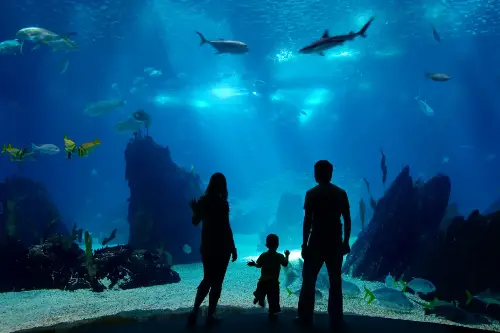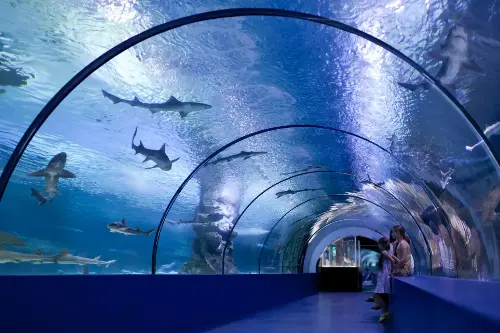Visiting an aquarium is not just an outing; it's a dive into an enchanting underwater world, offering endless opportunities for discovery and fun for families. Picture the glow in your child's eyes as they come face-to-face with colourful fish, undulating jellyfish, and the slow dance of seahorses. It's an experience that captivates and educates, bridging the gap between our world and the depths of the oceans.

The Educational Journey
Aquariums are living classrooms. Each tank and exhibit is a lesson in marine biology, ecology, and conservation. For curious minds, these aquatic exhibits offer tangible learning experiences. Children can observe the fragile ecosystems that exist beneath the waves, nurturing a deeper understanding of the importance of environmental stewardship. Interactive displays often describe the habitats, dietary needs, and unusual facts about the creatures, catering to various learning styles.
Engaging with the aquatic inhabitants, such as the comical pufferfish, encourages questions and discussions about biodiversity and the web of life. This hands-on knowledge not only bolsters educational development but also fosters a sense of responsibility towards preserving the natural world. It's where scientific concepts taught in classrooms come alive, making the learning experience all the more memorable.
The Fascination of Feeding Time
Many aquariums offer scheduled feeding times, which are not just entertaining but also incredibly informative. Watch your children's wonderment as sharks gracefully swoop in for their share, or rays glide to the surface to greet their caretakers. These feeding demonstrations often come with commentary, giving families insights into the diets and natural hunting behaviours of different species. It's a raw slice of nature that can be fascinating for children and adults alike.
Marine Petting Zoos
Interactivity is a significant part of the aquarium experience, bridging the gap between observer and the natural world. Touch pools and petting zones give children a tactile experience, feeling the textures and contours of starfish, sea urchins, or even baby rays and sharks. These safe and supervised encounters can help to dispel fears of unknown creatures and foster a compassionate attitude towards them.
By gently interacting with marine life, children build empathy and an understanding of the importance of gentle, respectful treatment of all creatures. They learn the consequences of their actions in a controlled environment, a lesson that extends far beyond the aquarium walls.

The Wonders of Diverse Habitats
Aquariums are fantastically designed to replicate various marine habitats, from the icy waters of the Arctic to the colourful coral reefs of the tropics. Each exhibit immerses visitors in different parts of the marine world, showcasing the diversity and adaptability of life. Children can walk through underwater tunnels, surrounded by the ocean's inhabitants, or marvel at the delicate balance of life in a mangrove forest tank.
Discovering how fish and creatures interact within their communities is not only fascinating but also sparks conversations about geography, climate, and adaptation. These immersive environments help children to appreciate the wonder and variety of life on Earth, teaching them the value of ecosystems great and small.
The Magic of Underwater Acrobatics
Aquariums often feature larger marine mammals, with dolphins and seals being common favourites. Watching them play, jump, and communicate can be enthralling. Many aquariums also offer educational shows where trainers demonstrate the animals' agility and intelligence, along with sharing information on conservation efforts.
While these performances are entertaining, they also demonstrate the complex social structures and behaviours of marine mammals, provoking a deeper curiosity in young minds about animal psychology and communication. It's one of the many ways that aquariums blend education with entertainment, creating a uniquely immersive learning environment.
Conservation in Action
Today's aquariums play a crucial role in conservation, and this ethos is woven into the fabric of their exhibits. Children can learn about endangered species and the efforts being taken to preserve them. Many aquariums participate in breeding programmes for rare fish and provide rehabilitation for injured marine creatures.
By showcasing these efforts, aquariums help instil the importance of conservation from a young age. Families can learn about simple ways to help protect the ocean, such as reducing plastic use, supporting sustainable seafood, or becoming involved in local beach clean-up efforts. It's an empowering message, showing that even the smallest actions can make a difference.
Making Memories to Last a Lifetime
The joy of an aquarium visit is not just in the sights but in the shared experiences. It's a place for family bonding, where memories are made, and stories are created to be told for years to come. Be it the shared laughter at a clownfish's antics or the joint amazement at a giant octopus unfurling its tentacles, these moments connect families and the natural world.
Through a delicate blend of fun, learning, and conservation, an aquarium visit becomes more than just an outing—it's an adventure into a magical marine universe, opening young eyes to the wonders of our blue planet.
